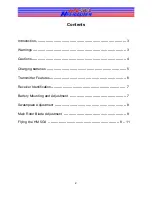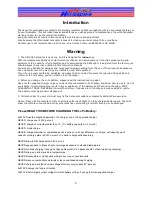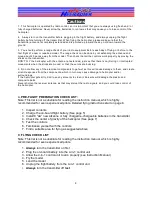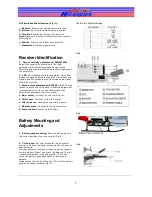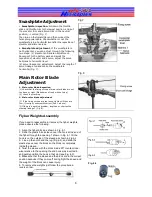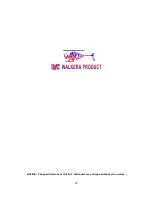
4
Cautions
1. This helicopter is operated by radio control, so it is important that you are always using fresh and / or
fully charged batteries. Never allow the batteries to run low as that may cause you to lose control of the
helicopter.
2.
Always turn on the transmitter before plugging in the flight battery, and always unplug the flight
battery before turning off the transmitter. When flying the helicopter, please make sure that the
transmitter antenna is completely extended and is pointed up toward the sky, not down toward the
ground.
3. You should perform a range check of your radio equipment before each day of flying, or before to the
first flight of a new or repaired model. The range check can be done by not extending the antenna and
move about 30 paces away from the model. Then check that all the controls work properly by moving the
sticks on the transmitter,
DON’T FLY the helicopter with the antenna not extended, just see that there is no jittering or interrupted
movements when the sticks are moved, or that the servos are buzzing.
4. Do not allow any of the electrical components to get wet as this will cause damage to them, and create
erratic responses from the components, which in turn may cause damage to helicopter and/or
surroundings.
If the helicopter gets dirty, don't use any solvents to clean it. Solvents will damage the plastic and
composite parts.
Never shorten the receiver antenna as that may disrupt the radio signals, and you could lose control of
the helicopter.
A.
PRE-FLIGHT PREPARATION CHECK LIST:
Note: This list is not a substitute for reading the instruction manual, which is highly
recommended for even experienced pilots. Detailed flying instructions start on page 8.
1. Inspect contents
2. Charge the on-board flight battery (See page 5)
3. Install 8 “AA” new Alkaline or fully charged re-chargeable batteries in the transmitter
4. Check the center of gravity of the helicopter (See page 7)
5. Test the controls
6. Familiarize yourself with the controls
7. Find a suitable area for flying as suggested above
B:
FLYING CHECK LIST
Note: This list is not a substitute for reading the instruction manual, which is highly
recommended for even experienced pilots.
1.
Always
turn the transmitter on first
2. Plug the on-board battery into the 4-in-1 control unit
3. Allow the 4-in-1 control unit to arm properly (see Instruction Manual)
4. Fly the model
5. Land the model
6. Unplug the flight battery from the 4-in-1 control unit
7.
Always
turn the transmitter off
last


